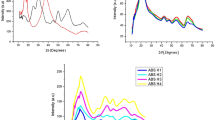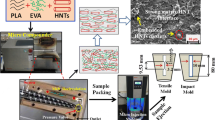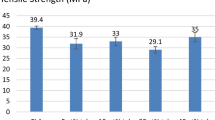Abstract
This research investigates the effect of talc additive on physical and mechanical characteristics of poly(lactic acid) (PLA) and poly(butylene succinate) (PBS) polymer blend. In the study, the talc content is varied between 0, 5, 10, and 20 parts per hundred resin (phr) and the PLA/PBS ratio is 80/20 w/w. The results reveal that talc enhances the mechanical properties of PLA/PBS blend. Specifically, tensile strength, Young’s modulus, and impact strength of PLA/PBS/talc composite increase as talc content rises. In addition, fracture toughness increases substantially as talc quantity is raised. The enhanced fracture toughness is attributable to nucleation of talc which promotes crystallization of PLA while hindering PBS crystal growth. Moreover, morphology analysis shows efficient distribution of talc in the polymer matrix.









Similar content being viewed by others
References
Kamm B, Gruber PR, Kamm M (2010) Biorefineries—industrial processes and products: status quo and future directions. Wiley, Hoboken, p 949
Nampoothiri KM, Nair NR, John RP (2010) An overview of the recent developments in polylactide research. J Biores Technol 101:8493
Tsuji H (2008) Polylactic Acid -Shokubutsu Yurai Plastic no Kiso to Ouyou. Yoneda Shuppan Co. Ltd, Tokyo
Auras R, Harte B, Selke S (2004) An overview of polylactides as packaging materials. J Macromol Biosci 4:835
Auras RA, Singh SP, Singh JJ (2005) Evaluation of oriented poly(lactide) polymers with existing PET and oriented PS for fresh food service containers. J Packag Technol Sci 18:207
Vainionpaa S, Rokkanen P, Tormal P (1989) Surgical application of biodegradable polymers in humman tissues. J Prog Polym Sci 14:679
Pivsa-Art W, Fujii K, Nomura K, Aso Y, Ohara H, Yamane H (2016) The effect of poly(ethylene glycol) as plasticizer in blends of poly(lactic acid) and poly(butylene succinate). J Appl Polym Sci 133(8):43044
Jompang L, Thumsorn S, Wong On J, Surin P, Apawet C, Chaichalermwong T, Kaabbuathong N, O-Charoen N, Srisawat N (2013) Poly(lactic acid) and poly(butylene succinate) blend fibers prepared by melt spinning technique. Energy Proc 34:493
Jiang L, Wolcott MP, Zhang J (2006) Study of biodegradable polylactide/poly(butylene adipate-co-terephthalate) blends. Biomacromol 7(1):199
Bhari K, Mitomo H, Enjoji T, Yoshii F, Makuuchi K (1998) Radiation cross linked poly (butylene succinate) foam and its biodegradation. Polym Degrad Stab 62:551
Doi Y, Kasuya K, Abe H, Koyama N, Ishiwatara S, Takagi K, Yoshida Y (1996) Evaluation of biodegradabilities of biosynthetic and chemosynthetic polyesters in river water. J Polym Degrad Stab 51:281
Bhatia A, Gupta RK, Bhattacharya SN, Choi HJ (2007) Compatibility of biodegradable poly (lactic acid) (PLA) and poly (butylene succinate) (PBS) blends for packaging application. J Korea-Austr Rheol 19:125
Oksman K, Skrifvars M, Selin JF (2003) Natural fibres as reinforcement in polylactic acid (PLA) composites. Compos Sci Technol 63:1317
Wang XH, Zhou JJ, Li L (2007) Multiple melting behavior of poly(butylene succinate). Eur Polym J 43:3163
Doi Y, Fukuda K (1994) Biodegradable plastics and polymer. Stud Polym Sci 12:627
Ujimaki T (1998) Processability and properties of aliphatic polyesters. Polym Degrad Stab 59:209
Shih YF, Chen LS, Jeng RJ (2008) Preparation and properties of biodegradable PBS/multi-walled carbon nanotube nanocomposites. Polymer 49:4602
Lapčík L, Jindrová P, Lapčíková B, Tamblyn R, Greenwood R, Rowson N (2008) Effect of the talc filler content on the mechanical properties of polypropylene composites. J Appl Polym Sci 110(5):2742
Stamhuis JE (1988) Mechanical-properties and morphology of polypropylene composites. 3. Short glass-fiber reinforced elastomer modified polypropylene. Polym Compos 9(4):280
Battegazzore D, Bocchini S, Frache A (2011) Crystallization kinetics of poly(lactic acid)-talc composites. Polym Lett 1(5):849
Shibata M, Inoue Y, Miyoshi M (2006) Mechanical properties, morphology, and crystallization behavior of blends of poly(l-lactide) with poly(butylene succinate-co-l-lactate) and poly(butylene succinate). Polymer 47:3557
Shakoor A, Thomas NL (2014) Talc as a nucleating agent and reinforcing filler in poly(lactic acid) composites. Polym Eng Sci 54(1):64
Battegazzore D, Bocchini S, Frache A (2011) Crystallization kinetics of poly(lactic acid)-talc composites. Exp Polym Lett 5(10):849
Huang A, Yu P, Jing X, Mi HY, Geng LH, Chen BY, Peng XF (2016) The effect of talc on the mechanical, crystallization and foaming properties of poly (lactic acid). J Macrom Sci Part B 55(9):908
Akbari A, Jawaid M, Hassan A, Balakrishnan H (2013) Epoxidized natural rubber toughened polylactic acid/talc composites: mechanical, thermal, and morphological properties. J Comp Mat 48(7):1
Pivsa-Art W, Fujii K, Nomura K, Aso Y, Ohara H, Yamane H (2016) Isothermal crystallization kinetics of talc-filled poly (lactic acid) and poly (butylene succinate) blends. J Polym Res 23(8):144
Picard E, Espuche E, Fulchiron R (2011) Effect of an organo-modified montmorillonite on PLA crystallization and gas barrier properties. Appl Clay Sci 53:58
Hassouna F, Raquez JM, Addiego F, Dubois P, Toniazzo Y, Ruch D (2011) New approach on the development of plasticized polylactide (PLA): grafting of poly (ethylene glycol) (PEG) via reactive extrusion. Eur Polym J 47:2134
Ren ZJ, Dong LS, Yang YM (2006) Dynamic mechanical and thermal properties of plasticized poly(lactic acid). J Appl Polym Sci 101:1583
Arruda LC, Magaton M, Bretas RES, Ueki MM (2015) Influence of chain extender on mechanical, thermal and morphological properties of blown films of PLA/PBAT blends. Polym Test 43:27
Asabia L, Jafari SH, Khonakdar HA, Hussler L, Wagenknecht U, Heinrich G (2013) Non-isothermal crystallization behavior of PLA/LLDPE/nanoclay hybrid: synergistic role of LLDPE and clay. Thermochim Acta 565:102
Hwang SY, Yoo ES, Im SS (2012) The synthesis of copolymers, blends and composites based on poly(butylene succinate). Polym J 44:1179
Ihn KJ, Yoo ES, Im SS (1995) Structure and morphology of poly(tetramethylene succinate) crystals. Macromol 28:2460
Piorkowska E, Kulinski Z, Galeski A, Masirek R (2006) Plasticization of semicrystalline poly(l-lactide) with poly(propylene glycol). Polymer 47:7178
García-Campo MJ, Boronat T, Quiles-Carrillo L, Balart R, Montanes N (2018) Manufacturing and characterization of toughened poly(lactic acid) (PLA) formulations by ternary blends with biopolyesters. Polymer 10:3
Yao SS, Pang QQ, Song R, Jin FL, Park SJ (2016) Fracture toughness improvement of poly(lactic acid) with silicon carbide whiskers. Macromol Res 24(11):961
Jin FL, Pang QQ, Zhang TY, Park SJ (2015) Synergistic reinforcing of poly(lactic acid)-based systems by polybutylene succinate and nano-calcium carbonate. J Ind Eng Chem 32:77
Acknowledgements
The authors would like to express sincere gratitude to the National Research Council of Thailand (NRCT) for research grant.
Author information
Authors and Affiliations
Corresponding author
Additional information
Publisher's Note
Springer Nature remains neutral with regard to jurisdictional claims in published maps and institutional affiliations.
Rights and permissions
About this article
Cite this article
Pivsa-Art, W., Pivsa-Art, S. Effect of Talc on Mechanical Characteristics and Fracture Toughness of Poly(lactic acid)/Poly(butylene succinate) Blend. J Polym Environ 27, 1821–1827 (2019). https://doi.org/10.1007/s10924-019-01478-z
Published:
Issue Date:
DOI: https://doi.org/10.1007/s10924-019-01478-z




